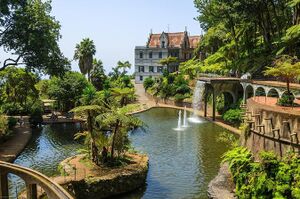Hestia Estate
| Hestia Estate | |
|---|---|
 | |
| General information | |
| Status | Residence |
| Type | Palace |
| Town or city | Arianna |
| Country | Timeria |
| Construction started | March, 1635 |
| Completed | August 21st, 1642 |
| Renovated |
|
| Owner | Hestia Familia |
The Hestia Estate is a palace in Arianna, Timeria and histroic residence of the Hestia Familia. The residence sits on 5,000 acres west of downtown Arianna and is considered the 7th District. The Entire Estate is officially recognized as a National Landmark under the Department of Interior. There are multiple buildings, gardens, and historic landmarks on the property. The estate, originally founded in 703 AD by the Hestia Familia, holds deep historical and spiritual significance, as the Hestia Familia also founded the city of Arianna the same year. The estate has been meticulously maintained and renovated over the centuries, with the current main structure dating back to 1635. The Hestia Estate, with its expansive grounds and rich heritage, serves as a symbol of Timerian history, culture, and faith.
History
The Hestia Estate has a storied history that traces back to the early days of Timeria. Established in 703 AD, the estate was originally a modest structure serving the needs of the Hestia Familia, who played a crucial role in the founding of Arianna. Over the centuries, the estate grew in size and importance, particularly as Arianna developed into a key city in Timeria.
The current main residence was constructed in 1635, reflecting the architectural style and cultural influences of that era. As the home of one of Timeria's most prominent families, the estate became a focal point for cultural and religious activities, particularly those related to the Sky Faith, which has deep roots in the region. The estate underwent significant renovations in 1915 to preserve its historic structures while incorporating modern amenities. Another round of renovations was completed in 1993 to restore and maintain the estate as a National Landmark and Coalition World Heritage Site.
Banquet of the Gods
The Banquet of the Gods was an annual celebration held by the Hestia Familia in which prominent members of the Sky Faith would travel to Arianna to celebrate the various Gods of the Sky Faith. The tradition started in 1053 when the first banquet was held at the Hestia Estate. The banquets were held at the Orario Temple located on the Hestia Estate.
Architectural Style
The Hestia Estate is a prime example of Coastal Classical architecture with Neo-Skyist influences, a style that blends traditional Timerian design with elements that reflect the spiritual significance of the Sky Faith. The estate's main living quarters are designed to harmonize with the surrounding natural landscape, featuring open courtyards and expansive terraces that offer breathtaking views of the Albarine Sea.
The surrounding structures, including various temples, gardens, and water features, are designed to complement the main residence. These include intricate gardens, art depicting scenes from Sky Faith mythology, and sculptures honoring the deities of the faith. The Orario Temple, in particular, is a focal point of the estate, designed with a circular layout to symbolize the eternal cycle of life, death, and rebirth.
Layout and Grounds
The Hestia Estate covers a significant area, with the main residence occupying only a small portion of the overall grounds. The estate includes multiple surrounding structures, each serving a unique purpose. These include guesthouses, temples dedicated to various deities of the Sky Faith, and pavilions for gatherings and celebrations.
The estate's gardens are renowned for their beauty and spiritual significance. They feature a mix of native and exotic plants, carefully arranged to reflect the themes of harmony and balance central to the Sky Faith. The gardens also include several water features, such as reflecting pools and fountains, designed to evoke a sense of peace and tranquility.
Cultural Significance and Traditions
One of the most notable traditions associated with the Hestia Estate is the Banquet of the Gods, an annual celebration that dates back to 1053 AD. This grand event, hosted by the Hestia Familia, brought together prominent members of the Sky Faith from across Adula to honor the various gods of the faith. The banquet was traditionally held at the Orario Temple on the estate grounds, with rituals, feasts, and performances that celebrated spiritual and cultural heritage.
Although the Banquet of the Gods is no longer held in its original form, the tradition lives on through various cultural events and festivals that take place at the estate throughout the year. These events continue to draw visitors from across Timeria and beyond, making the Hestia Estate a living testament to the enduring legacy of the Sky Faith.
Visitor Information and Attractions
Today, the Hestia Estate is open to the public and offers a range of attractions for visitors interested in Timerian history, architecture, and culture. The estate features guided tours that highlight its architectural and historical significance, with a focus on the role of the Sky Faith in shaping the estate's design and traditions.
- Orario Temple: The spiritual heart of the estate, where visitors can learn about the rituals and traditions of the Sky Faith.
- Starlight Gardens: A series of meticulously designed gardens that offer a peaceful retreat for visitors, featuring a diverse array of plants and water features.
- Hestia Hall: A museum within the estate that houses artifacts, artworks, and historical documents related to the Hestia Familia and the estate's history.
- The Banquet Room: A grand hall where replicas of the original Banquet of the Gods are displayed, giving visitors a glimpse into the opulence and significance of this historic event.
- The Reflecting Pool: A serene water feature that mirrors the sky and surrounding gardens, symbolizing the harmony between the heavens and earth.
